All About Day of the Dead Altars
Inside: An overview of a Day of the Dead altar, and what each element in an ofrenda means.
Day of the Dead welcomes the temporary return of souls from the afterlife, during November 1 and 2. Dí de Muertos is mainly known as a Mexican holiday, but versions of it are celebrated across most of Latin America.
The holiday is an intimate time to pause and remember those who have passed on, while celebrating their lives. A mix of Pre-Hispanic and Catholic beliefs and customs, Día de Muertos is full of colors, smells, family, and remembrance.
Day of the Dead a separate holiday from Halloween, even though the dates are close together. On the surface, they may seem to have common elements, but there are significant differences between Halloween and Day of the Dead.
It does share some traditions with All Soul’s day (or All Saint’s Day), and can be known by different names: Día de los Difuntos, and Día de Todos los Santos. November 1 honors children who have passed, and November 2 honors adults.
Altars can vary from simple to elaborate, and by region. This post covers the common elements found in most Day of the Dead altars, especially in Mexico.
Contents:
1. What is a Day of the Dead altar?
2. What do you put on an ofrenda?
3. What do the elements of an altar represent?
4. See a tour of a Día de los Muertos altar.
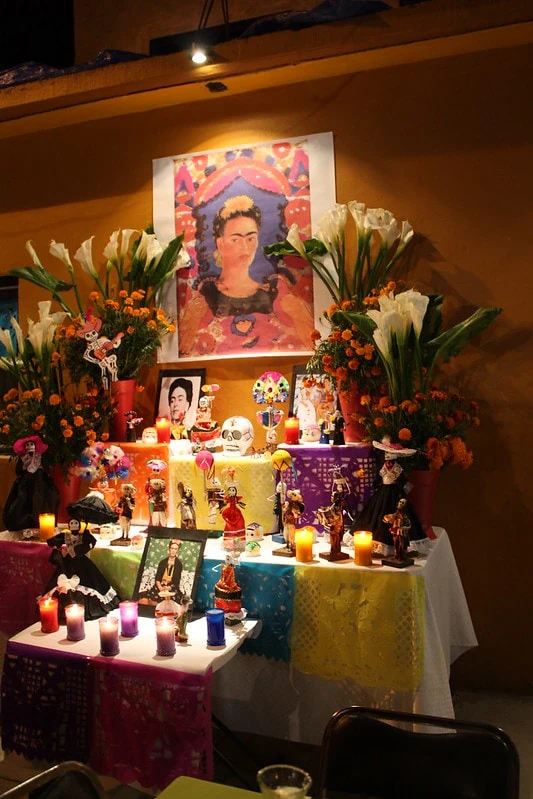
What is a Day of the Dead Altar?
The most common element of Day of the Dead is the altar– ofrenda, in Spanish. It’s a sort of shrine that families create to honor and remember their departed ancestors and family members.
It usually consists of a table, boxes, or other surface draped by black or white cloths. The family decorates it with candles, bright colors, and meaningful items that reflect four elements: earth, water, fire, and air.
The basic altar can be constructed with different levels. Two levels can represent heaven and earth, while three can mean earth, purgatory, and heaven. In other places, people use seven levels to represent the steps up to heaven or the afterlife.
Some altars also include a path of flowers to guide spirits up to the altar.
What items are on a Day of the Dead Altar?
Altars can vary, but they usually contain some core symbols. They altar is created with care, as each ofrenda reflects the individual souls they mean to honor and the region the family lives in.
Here’s a quick list of the main elements you might find on an ofrenda.
- Candles
- Pan de Muerto
- Flowers
- Religious Symbols
- Papel Picado
- Sugar Skulls
- Incense
- Personal Objects
- Water
- Salt
- Photographs
- Plate of Food
- Drinks
- Petate
- Fruits
- Arc
What do the elements on the Altar represent?
Let’s take a look at what each of these elements are and what they might symbolize.
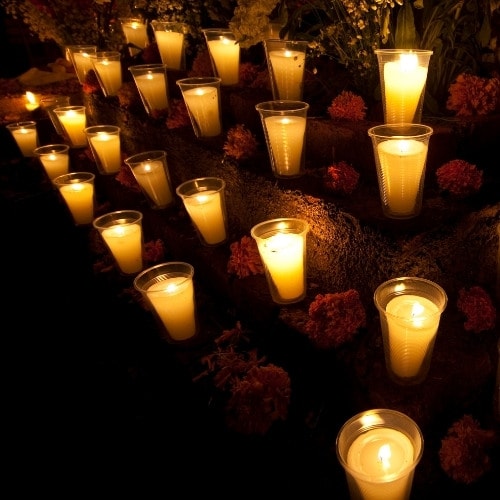
Candles
Candles are an essential elemental of ofrendas. They keep vigil throughout the night, illuminating the way for visiting souls.
Candles symbolize hope and faith, along with the life element of fire. Some families place one candle per person that they are remembering, and other scatter them patterns.
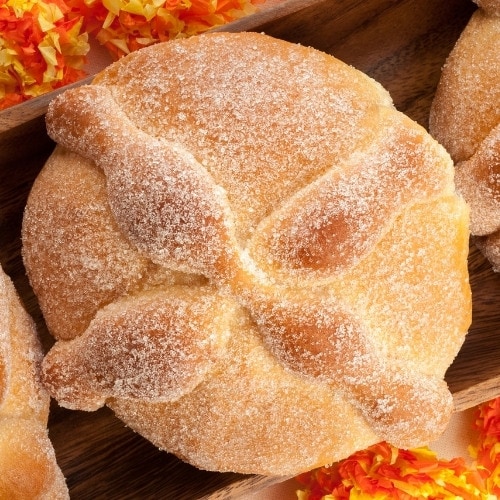
Pan de Muerto
Pan de Muerto is a kind of sweet bread that can be found on most altars in Mexico. It is usually round, with the shape of crossed bones on the top.
There are variations on this. In Andean regions of South America, for example people make bread in the shape of a doll, known as tantawawas (or guagas).
From Catholic traditions, pan de muerto can also symbolize the body of Jesus. It can also represent gifts from the earth and hospitality.
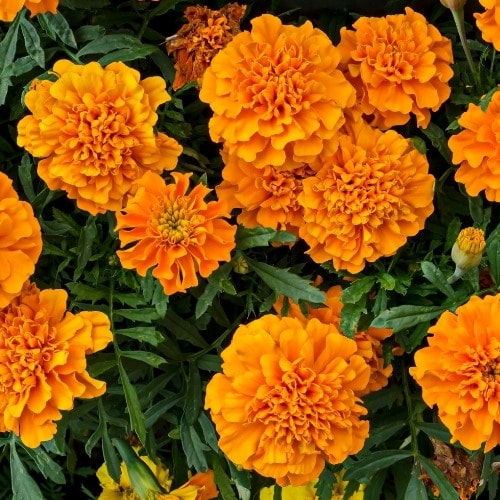
Flowers
Marigold flowers, called cempasúchil, are often placed around the altar in Mexico. Cempasuchil petals are strewn on the floor, their color and strong scent creating a path to guide visiting souls to the altar.
Some say that orange is the only color visible to souls from the afterlife, and so these “flowers of death” are an important component in altars and cemeteries. White flowers are also common.
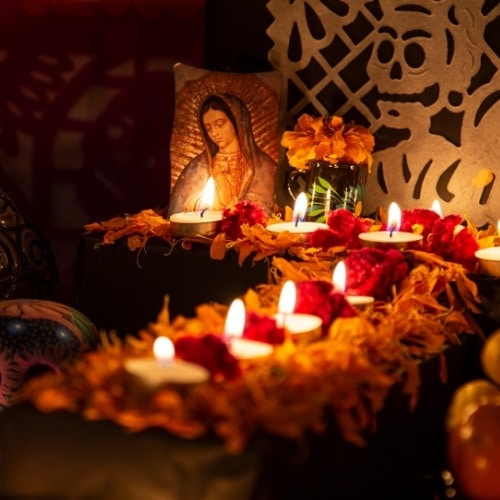
Religious Symbols
As the day is also rooted in Catholic traditions, religious objects are often present on the altar.
Some families include objects such as images of saints, Jesus, the Virgin Mary, rosaries, and crucifixes. Different elements can be arranged in the shape of a cross as well.
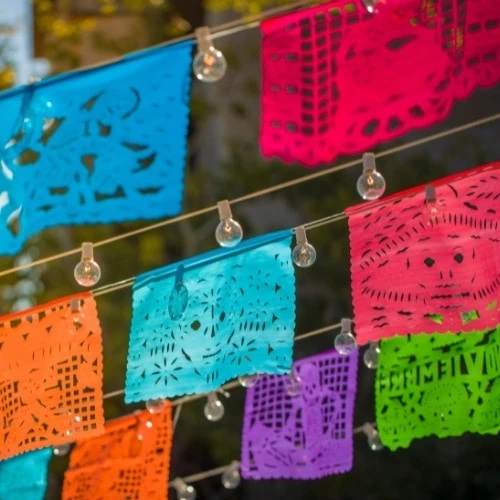
Papel Picado
Papel picado is brightly colored tissue paper with cut-out designs, and it’s one of the most iconic Day of the Dead decorations. The designs are often images like skulls, saints, flowers, and candles.
Papel picado symbolizes the union between life and death, and the joy of life. As it flutters out in the streets and in cemeteries, it can represent the life element of air.
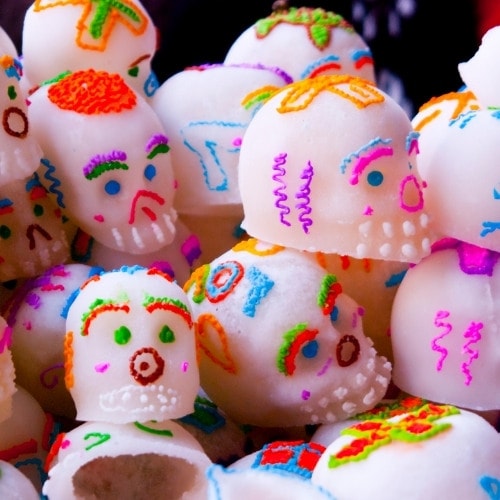
Sugar Skulls
Sugar skulls represent the presence of death, along with an acceptance that death is part of life. They are rooted indigenous traditions.
Some edible skulls, or calaveras, are made out of white sugar and brightly decorated. Calaveras can also be made of chocolate, wood, clay, or other substances.
Related: Sugar Skull Coloring Pages
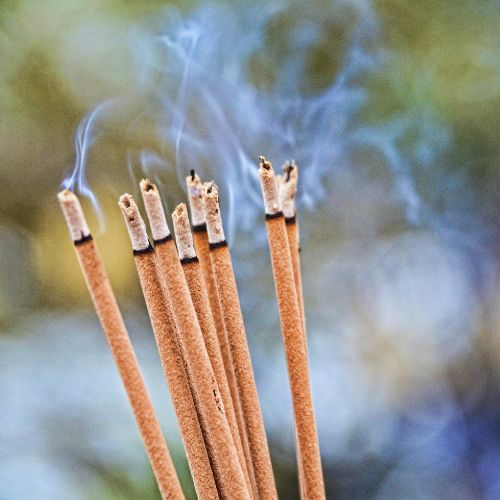
Incense
Originally, indigenous people in Mexico used copal incense in their religious ceremonies, made from the resin of trees.
With the arrival of the Spaniards, incense became popular and many altars include incense to aid with prayers. Incense is also said to cleanse the air, keeping bad spirits or negative energy away.
Aromatic herbs such as basil, rosemary, and chamomile can be used on the altar or to cleanse the space for the altar.

Personal Objects
Families commonly include meaningful items that belonged to the deceased person or that reflect what they liked. This might mean toys for children, an object from the person’s profession, or a hobby they enjoyed.
If an altar is honoring a child’s soul, el izcuintle is often included. This is a toy puppy to make visiting children happy, and the izcuintle is said to help souls cross the river Chiconauhuapan on the way to Mictlán (the Aztec underworld).

Water
A glass of water is set out to welcome thirsty souls after their long journey from the afterlife and back. Water can also symbolize purity.

Salt
Salt is another element of purification.
It is sometimes shaped into a cross to represent the four cardinal points (north, south, east, and west). Sometimes, ashes are used in place of salt.

Photographs or Paintings
Families often place portraits of their ancestors and relatives on the altar. These are often set up at the top of the altar or in a prominent place. When altars are set up for multiple relatives, there is usually a photo or portrait of each person.
“Day Of The Dead Altar” (CC BY-SA 2.0) by St0rmz
Plate of Food
Families often include traditional food and favorite dishes for their departed loved ones. It is said the aroma of the food feeds their hungry souls. The food is often served from earthen pots and dishes.
Some of the most common food and drinks include:
- Mole (a Mexican dark sauce or marinade)
- Hot chocolate
- Atole (a corn drink)
- Tamales (dough made from corn and steamed in a corn or banana leaf)
- Candies (especially set out for children; dulce de alfeñique is common)
- Pozole (traditional Mexican stew with hominy and meat)
- Calabaza en tacha (candied pumpkin)
- Arroz con leche (rice with milk)
- Horchata (sweet drink with rice and milk)
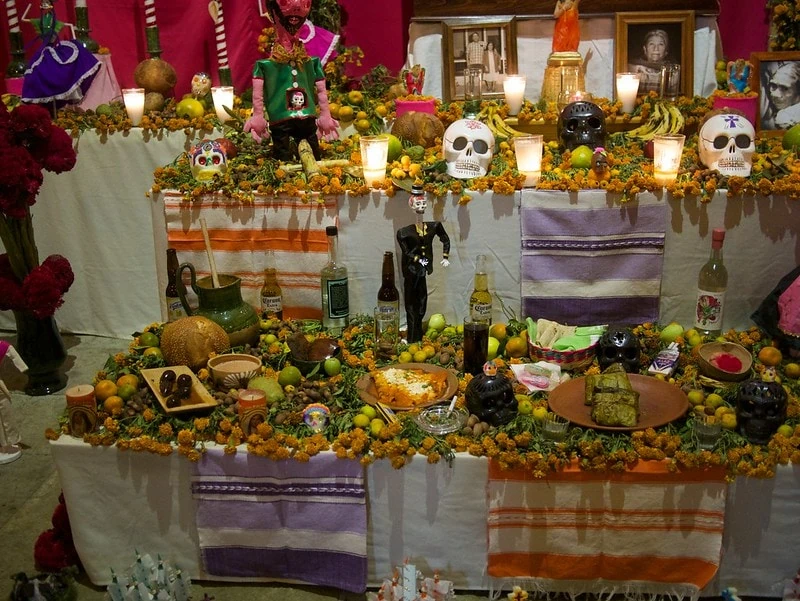
Drinks
Many familes include drinks like Tequila pulque, or mezcal, an agave-based liquor, to welcome and cheer up the visiting adult souls. People who smoked may also have cigarettes placed on their altar.
Petate
These are woven mats made from palm trees, and set on the floor to provide a place to rest.

Fruits
In addition to specific dishes of food, fruit is commonly placed on altars as an element of earth and what it provides for us.
“Day of the Dead altar, Oaxaca” (Public Domain) by lisafree54
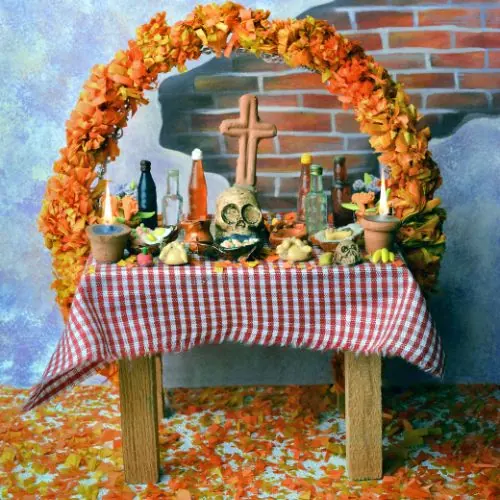
Arc
Some altars include an arc that stretches along the back of the ofrenda. It can be adorned with flores de cempasúchil or lights.
Tour Some Altars
Seeing examples of altars is of course the best way to experience them.
This site includes dozens of examples of real-life Día de Muertos ofrendas.
This video is in Spanish, but it offers an intimate look into how a family in Mexico creates their altar.
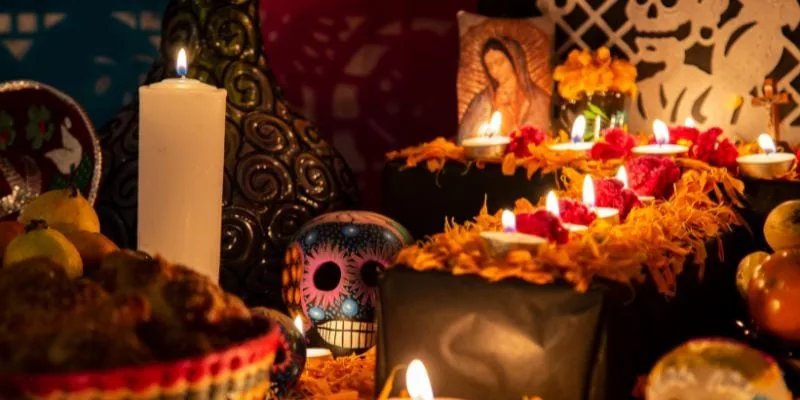
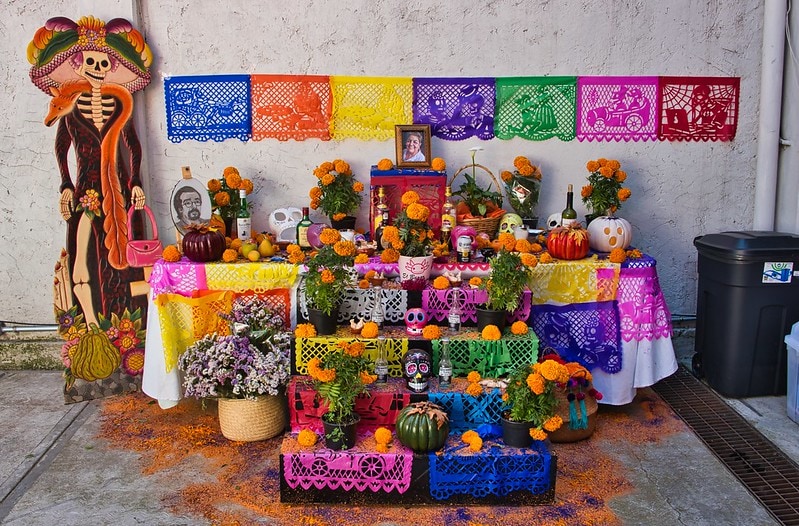

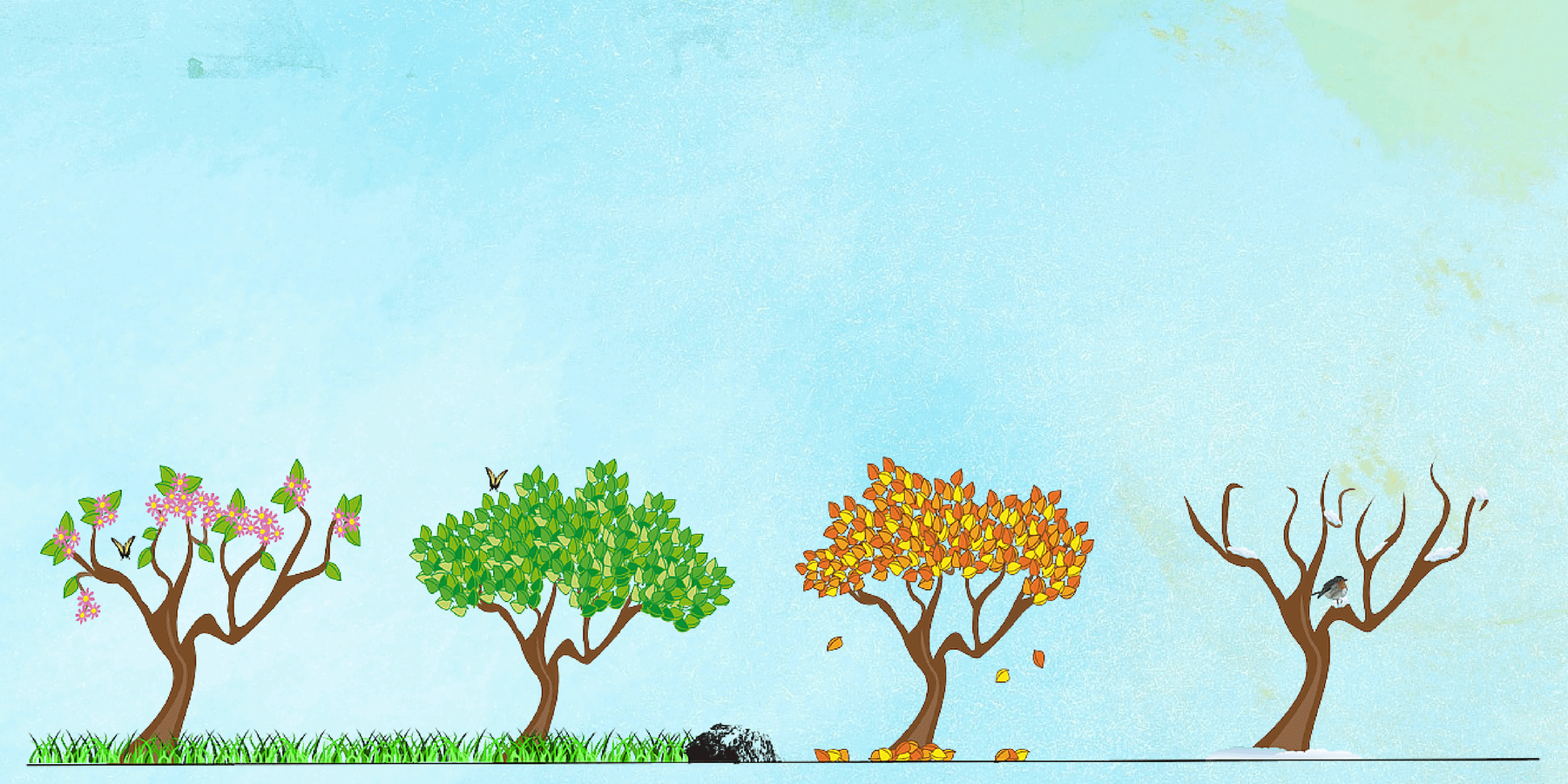

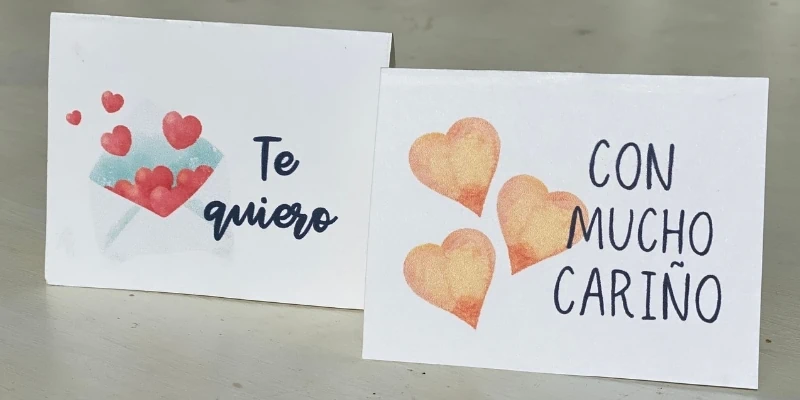
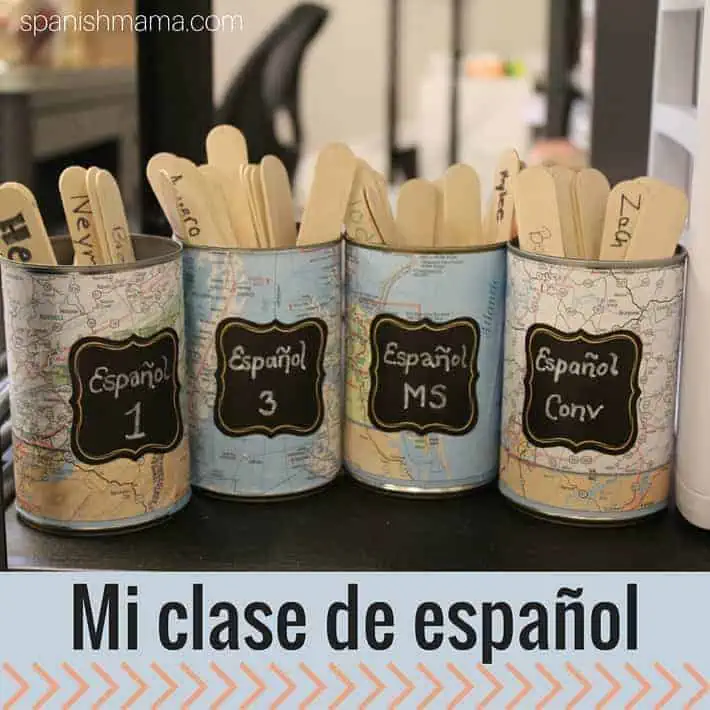

Thank you for this. Appreciate the explanations.
Respectfully: An altar is not an ofrenda. It is an altar/table/platform upon which and an ‘ofrenda’ – a gift – is placed.
(Also, there are a couple of typos within the text.)